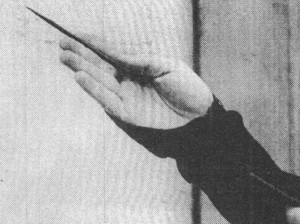Fukibari (3.5e Equipment)
| |||||||||||
| Size | Cost1 | Damage | Weight1 | hp | |||||||
|---|---|---|---|---|---|---|---|---|---|---|---|
| Fine | * | — | * | 1 | |||||||
| Diminutive | * | — | * | 1 | |||||||
| Tiny | * | 1d2 | * | 1 | |||||||
| Small | 1 gp | 1d3 | 1/2 lb. | 1 | |||||||
| Medium | 1 gp | 1d4 | 3 lb. | 1 | |||||||
| Large | 2 gp | 1d6 | 6 lb. | 2 | |||||||
| Huge | * | — | * | 4 | |||||||
| Gargantuan | * | — | * | 8 | |||||||
| Colossal | * | — | * | 16 | |||||||
| |||||||||||
Fukibari are very thin, almost dagger-like needles usually around 2-3 inches long. Fukibari are often used with a blowgun, but are sometimes concealed in the mouth under the tongue or along the roof of the mouth and shot at an unsuspecting target at short range for a surprise attack. If used in this way treat the fukibari as a weapon requiring its own feat or taking appropriate penalties. If used in conjunction with poison, the rate of accidental self-poisoning increases by 5%; even if the user has the Poison Use feat or Class Feature, they risk poisoning themselves in this manner.
A fukibari used as a melee weapon is treated as a light improvised weapon (–4 penalty on attack rolls) and deals damage as a dagger of its size. Fukibari come in a wooden case that holds 10 fukibari. A fukibari that misses has a 50% chance of being destroyed or lost.
Prices and weights are for twenty fukibari.
Back to Main Page → 3.5e Homebrew → Equipment → Mundane Weapons
